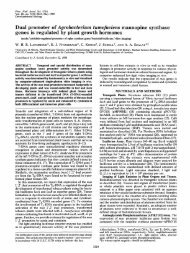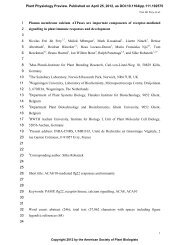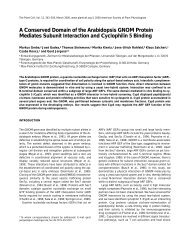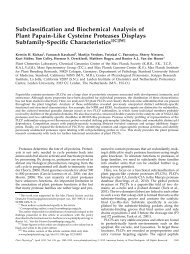1 Transposon and T-DNA mutagenesis
1 Transposon and T-DNA mutagenesis
1 Transposon and T-DNA mutagenesis
You also want an ePaper? Increase the reach of your titles
YUMPU automatically turns print PDFs into web optimized ePapers that Google loves.
Protocol 5.<br />
Continued<br />
10 x TEE: 108 g Tris base. 55 g boric acid.<br />
9.3 g NalEDTA per litre<br />
Phenol (saturated):chloroform(1:l)<br />
3 M sodium acetate pH 5.5<br />
Isopropanol<br />
14 <strong>DNA</strong> ligase<br />
70% (vh) ethanol<br />
. LB medium (per litre): 10 g B ~ tryptone, ~ ~ o<br />
5 g Bacto yeast extract, 10 g NaCl<br />
A. Preparation of <strong>DNA</strong> samples for electroporation<br />
Overnight E. coliculture (e.g. MC1061)<br />
1 mM Hepes pH 7.0<br />
1 mM Hepes pH 7.0, 10% glycerol<br />
SOC: 2% (wlv) Bacto tryptone, 0.5% (wh)<br />
Bacto yeast extract, 10 mM NaCI, 2.5 mM<br />
KCI, 10 mM MgCI,, 10 mM MgSO., 20 mM<br />
glucose<br />
Ampicillin. 100 mg/ml stock (filter sterilized)<br />
1. Isolate <strong>DNA</strong> from mutant plants (see Protocol .A, or ref. 74).<br />
2. Determine by Southern analysis (531, which restriction enzyme is most<br />
suitable to use for plasmid rescue. The size of flanking <strong>DNA</strong> to be<br />
rescued should be optimally in the range of 1-4 kb.<br />
3. Digest 5 kg of <strong>DNA</strong> (but as little as 100 ng can be used) with 25 U of<br />
the appropriate enzyme in 100 111 for 2 h. Check the digestion (5 ~ 1 on )<br />
an agarose gel.<br />
4. Phenol:chloroform extract <strong>and</strong> precipitate the <strong>DNA</strong> with NaAcI<br />
isopropanol (10 rnin -20°C), then centrifuge for 10 rnin at full speed.<br />
5. Resuspend in sterile, distilled H,O (20-50 ~glml), add ligation buffer<br />
(53). <strong>and</strong> self-ligate overnight with 2.5 U T4 <strong>DNA</strong> ligase at 14°C.<br />
6. Phenol:chloroform extract, NaAc/isopropanol precipitate the <strong>DNA</strong>, wash<br />
twice with excess 70% (vlv) ethanol, dry, <strong>and</strong> resuspend in sterile,<br />
distilled H20 at 10-100 pglml.<br />
B. Preparation of E. coli cells<br />
1. Inoculate 200 ml of LB with 2 ml of overnight E. coli (e.g. MC1061)<br />
culture. Grow for 2 h until OD550 reaches 0.5, <strong>and</strong> centrifuge the cells<br />
(fixed-angle rotor) at 4°C with 16000 r.c.f. for 10 min.<br />
2. Resuspend the cells in 100 ml of 1 mM Hepes pH 7.0 at O°C,<br />
recentrifuge, <strong>and</strong> resuspend in 50 ml of 1 mM Hepes. Recentrifuge <strong>and</strong><br />
resuspend in 5 ml of 1 mM Hepes, 10% (vlv) glycerol.<br />
3. Transfer the cells to Eppendorf tubes'<strong>and</strong> pellet them at 4°C (10 min,<br />
2100 r.c.f.). Resuspend in 400 p1 of 1 mM Hepes, 10% (vlv) glycerol.<br />
4. Mix 40 pI of the cells with 10 p1 of <strong>DNA</strong> in a pre-cooled cuvette for<br />
electroporation, e.g. a Bio-Rad Gene Pulser (25 kF, 2.5 kV, 200 A, <strong>and</strong><br />
4.8 msec). Immediately after electroporation add 1 ml of SOC (75) <strong>and</strong><br />
incubate cells for 1 h with shaking at 37°C.<br />
5. Centrifuge cells briefly (20 sec) at full speed, resuspend in SOC, <strong>and</strong><br />
plate aliquots on LB with ampicillin (100 ~glml).<br />
Protocol 6. Amplification <strong>and</strong> direct sequencing of T-<strong>DNA</strong> tagged<br />
plant <strong>DNA</strong>fragments by long-range IPCR (LA-IPCR)<br />
Equipment <strong>and</strong> reagents<br />
Thermocycler<br />
Automated sequencer<br />
Equipment <strong>and</strong> reagents for CsCl b<strong>and</strong>ing<br />
(74-76)<br />
. Qiagen <strong>DNA</strong> purification tip (optional)<br />
ABI Prism Dye Terminator Cycle<br />
Sequencing Kit (PE Applied Biosystems)<br />
Restriction enzyme that cleaves within T-<br />
<strong>DNA</strong> insert<br />
T4 <strong>DNA</strong> ligase<br />
Method<br />
Primers for nested PCR<br />
. Elongase (Gibco BRL)<br />
0.8% (w/v) agarose (electrophoresis grade)<br />
in 0.5 x 1 BE<br />
10 x TEE: 108 g Tris base, 55 g boric acid,<br />
9.3 g Na,EDTA per litre<br />
Phenol (saturated):chloroform<br />
lsopropanol<br />
. 0.3 M sodium acetate pH 6.0<br />
1. Purify high quality plant <strong>DNA</strong> by CsCl b<strong>and</strong>ing or on a miniscale with<br />
or without CTAB precipitation as described (see Protocol 2, <strong>and</strong> refs<br />
74-76). Digest it with a restriction endonuclease which cleaves within<br />
the T-<strong>DNA</strong> insert.<br />
2. Self-ligate the digested <strong>DNA</strong> (0.5 pg) as described ih Protocols 2, 3,<br />
<strong>and</strong> 5.<br />
3. Optional: digest the ligated <strong>DNA</strong> with a restriction endonuclease which<br />
does not cleave within the T-<strong>DNA</strong>, but cleaves the plant <strong>DNA</strong> fragment<br />
flanking the leftor right T-<strong>DNA</strong> end.<br />
4. Design two sets of nested PCR primers:<br />
(a) One pair facing the T-<strong>DNA</strong> end (left or right).<br />
(b) Another pair facing the restriction endonuclease cleavage site<br />
within the T-<strong>DNA</strong> which was used in step 1.<br />
5. Use half of the <strong>DNA</strong> in elongase PCR (BRL) or LA-PCR (Takara Shuzo<br />
Co.) for long-range amplification of large plant <strong>DNA</strong> fragments with a<br />
primer set facing the T-<strong>DNA</strong> end (left or right) <strong>and</strong> the endonuclease<br />
cleavage site within the T-<strong>DNA</strong> (step 1). Assemble the reaction mixes<br />
as recommended by the suppliers. Denature the template at 95°C for 2<br />
min, <strong>and</strong> perform.35 cycles of amplification (94°C for 30 sec, 65°C for<br />
30 sec, 68°C for 8 rnin), followed by elongation at 68°C for 10 min.<br />
6. Use one-tenth of the PCR mix to detect the product on an agarose gel,<br />
then gel isolate the PCR amplified fragments from the rest of the PCR<br />
mix.<br />
7. If the yield is about 0.5 pg or more, purify each amplified <strong>DNA</strong> fragment<br />
with phenol:chloroform extraction <strong>and</strong> isopropanol precipitation<br />
(0.54 vol. isopropanol, 0.1 vol. 3 M Na acetate pH 6.0), or alternatively<br />
on a Qiagen tip. Use directly as a template for sequencing with an ABI






